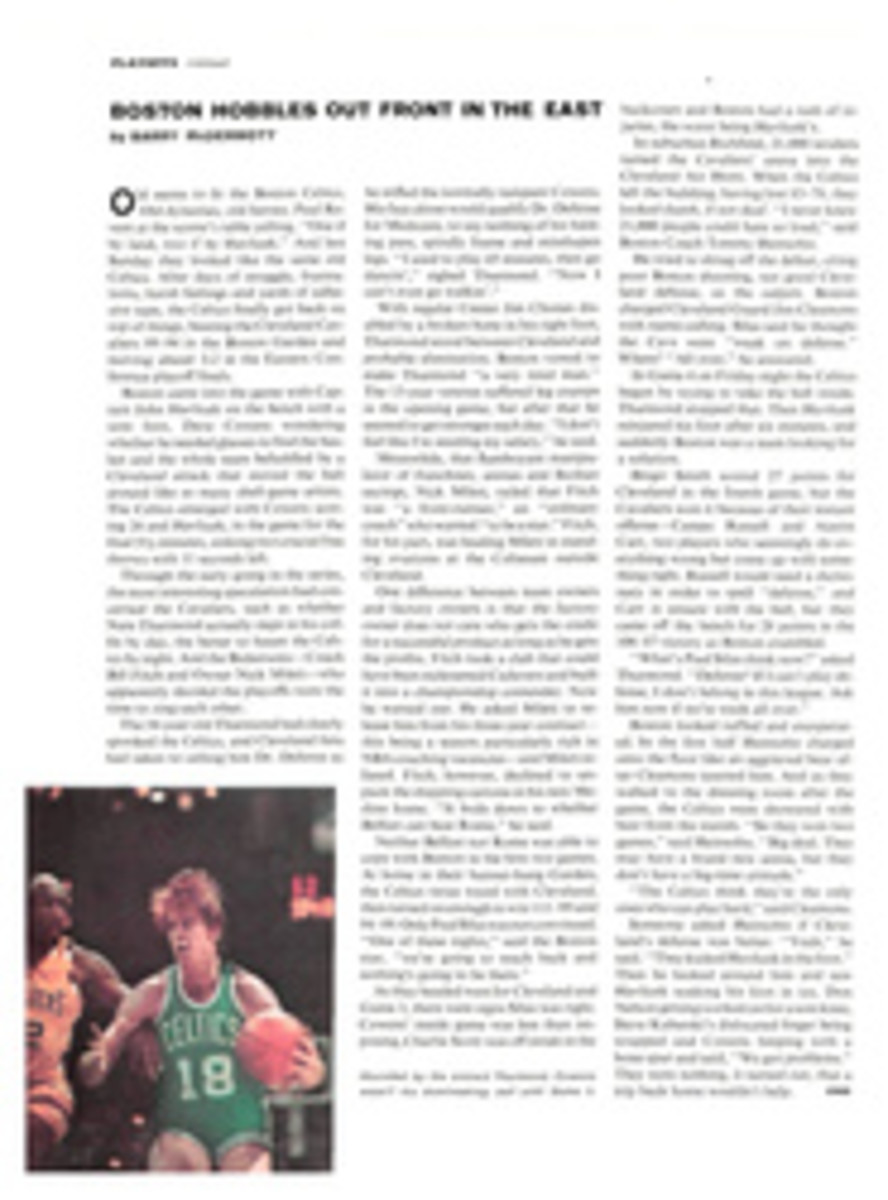
On the beam for Montreal
There were a great many stars twinkling on Kim Chace's leotard last week—red, white, blue and tiny silver ones—as she and 25 other girls competed in the Los Angeles Sports Arena for the six berths on the U.S. Olympic gymnastic team. There was no star among them yet; they were just the 26 best gymnasts in the country. But no fewer than 15 of them probably deserve to go to Montreal in July.
Alas, an Olympic team is composed of but six competitors, plus an alternate, and making that elite group required more than confidence, daring tricks and a winning smile. It required nerves like piano wire and a lot of stamina, and the seven girls who turned out to have that were Kathy Howard, Kolleen Casey, Kim Chace, Debbie Willcox, Carrie Englert, Leslie Wolfsberger and alternate Jodi Yocum.
Several of the competitors were as young as 14; the oldest, Olympians Kim Chace and Roxanne Pierce, were veterans of 20 and 21. Never before had the Olympic Trials produced such an assemblage of youth and talent. "In the past you could pretty much predict who would make the team," said Frank Bare, the executive director of the U.S. Gymnastics Federation. "We used to have superstars who could miss a move and still make the Olympics. This year, if a girl has a break in one routine, there are 10 right behind her to take her place."
Indeed, from the start the scores were that close. The Trials, spread over three days, required 16 performances—two compulsory and two optional routines in each of the four women's events. "It is the survival of the fittest and the toughest," said Meet Director Bud Marquette. And those who were not quite fit had to be tougher.
The toughest, if not the fittest, was Kathy Howard, the 17-year-old high school senior from Oklahoma City who finished a strong and surprising second to Rumania's peerless Nadia Comaneci in the American Cup in New York. But ill fate befell Howard just a couple of weeks before the Trials. During a tumbling workout she landed with her left heel on her right big toe, hard enough to break the bone. Taping the big toe to the one next to it and putting the pain out of her mind, she performed an optional floor exercise on the opening night of the Trials that earned her a 9.9 score, just .1 shy of perfect.
Slightly less tough was Ann Carr, the 18-year-old Philadelphian who was by anybody's standards on the road to stardom when she won five gold medals at the Pan-American Games last October. The day before the American Cup she sprained her left ankle practicing a double-twisting somersault. At Los Angeles she succumbed to the pressure, slipping off the beam and falling from the bars. "She came to the meet running scared," said her coach, Bill Coco. "Holding back. And that's when you run into trouble."
If the Trials themselves required an unrelenting mind and an iron body, just getting there had been no cakewalk. There were qualifying competitions galore, regional ones and semifinal ones, and anyone who did not place among the first 15 in last year's Nationals had to have an average score of 8.75 at one of two qualifying meets held last December in Houston or in February in St. Paul. More important, America's best women gymnasts had not only to worry about qualifying themselves, but they also had to qualify the country.
In the past, any country could enter a gymnastics team at the Olympics, but because the number of nations competing in the sport had escalated to 20 in recent years, qualification meets became necessary for 1976. In 1974, the International Gymnastics Federation ruled that the 1974 World Games, in Varna, Bulgaria, were to serve as the first of such qualifying competitions, with the top six nations going to Montreal automatically. Unfortunately, there is as much political hanky-panky in the judging of gymnastic performances as there is in judging figure skating. At Varna, with two-thirds of the judges hailing from Communist bloc countries and the free world representatives acting like agile fence-sitters, the U.S. men's and women's teams were dealt the bad cards. The men finished eighth and the women seventh.
In order for us to qualify for the 1976 Olympics, the U.S. Federation had two dual meets early this year—one with Canada in Toronto, the other with Rumania in Tucson. The scores, fair and certainly good enough for a berth in Montreal, were submitted to the International Federation, but at this point, and with only one month to go until the women's Olympic Trials, Arthur Gander, the autocratic Swiss president of the Federation, dropped a bomb. He accused several countries of inflating the scores, naming specifically Cuba, Canada, Italy and The Netherlands, and called for additional qualifying meets for men and women in Germany in May.
Although Gander's decision violated the statutes of the Federation, the meets would have been a good idea, had the judging started from scratch. Instead, 60% of the points already recorded in the previous qualifying meets were accepted, the meets in Germany only accounting for 40% of the total scores. The U.S. men's and women's teams qualified in first place, with performances far superior to everybody else's, but thanks to Gander's 60% present, every suspect nation with the exception of Cuba managed to qualify also.
Fortunately, the U.S. Trials did not have to be canceled, and when the final optionals started last Saturday night, the atmosphere at the Sports Arena was electric. Would Kathy Howard hold her lead or would little Kolleen Casey overtake her? Would Debbie Willcox, the only woman in the world who does a forward somersault on the beam—a feat more difficult than Olga Korbut's celebrated backflip—make the team? Would Kim Chace go to Montreal and lend experience and leadership to a team so young?
The final scrambling had been hectic. The highest score, a 9.9, had gone to 14-year-old Sharon Livieri for a piked Tsukahara vault perhaps only Comaneci could have topped. But she finished in 19th place. Winner Howard dropped behind Casey when she slipped off the uneven bars, but pulled herself together for the grand finale—her dazzling floor exercise—and won the meet by .1 of a point.
"She put everything she had into that routine," said Coach Mary Welin. "When Kathy first came to my gym in 1971, she couldn't even do a cartwheel. But she had talent and she had no fear."
Before Howard became a gymnast, she enjoyed track—sprinting, long-jumping, high-jumping—and perhaps it is because of these activities that she is now such an excellent leaper in the floor event. Only last January she learned a new dismount on the bars, which she hopes will become known as the Howard Back. It is a back sole-circle gainer on the high bar, with her toes placed between her hands—a swing back, a jump up and then a forward and a back somersault. "If you overturn, you land on the low bar," said Welin. "If you underturn, you land with your head on the floor." In warming up for a meet, Kathy indeed once fell on her head.
But while Howard managed to put it all together in her last event, Kim Chace was steadily adding up points in all four of the final days' routines.
At Munich, Chace placed "18th in the world," as she says proudly, and "second in the U.S." to Cathy Rigby. In 1973, Chace hung up her leotards, became Mrs. Charles Boyle and had a son, Christopher, who is now two. Last May she divorced Boyle and unretired. "I want to show other women," she said, "that when a woman has had a baby she can get back into shape. I want the American girls to know that life doesn't end in this sport when you have had a child. In the last Olympics we came so close to winning a medal I think we can do it again."
The fourth place the American women gained as a team at Munich was their best result since 1952, when women's gymnastics were included in the Games. Now, with Howard, Chace, et al, this year's chances seem even brighter. "There is only one other team that has as much depth as we have," says Frank Bare. "Russia. The Rumanians have two outstanding girls and the East Germans have two, but it takes six to go out there and add up the scores in team competition. I feel if the judging is fair, our women could very well win their first medal."
In Munich, when Czechoslovakia, then a well-established power in the sport, had to be content with a fifth in the women's team scoring, the Czech coach turned to U.S. Coach Muriel Grossfeld and said, "Congratulations. But you will never beat us again." She may have to eat her words.
PHOTO
Ready for Korbut and Comaneci, here are the U.S. gymnasts: Leslie Wolfsberger, Kolleen Casey, Kathy Howard, Carrie Englert, Debbie Willcox, alternate Jodi Yocum, and Kim Chace.

